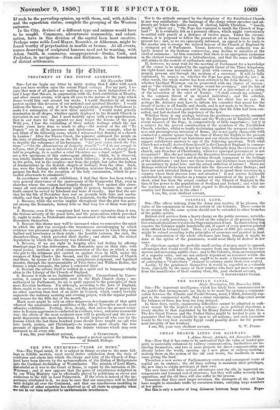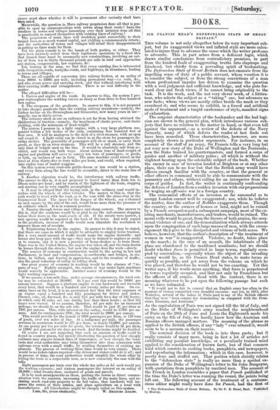CHEAP BRANCH LINES FOR RAILWAYS.
1 Adam Street, tidelphi, 4th November 1850.
Sut—Now that it has come to be understood that the value of landed property is materially enhanced by railway communication, landholders are bestirring themselves, and two or more projects for direct communication are already before the world, opening up a new phase of railway-making ; making them on the system of the old road trusts, the landlords in some cases giving the land.
Therefore a new series of Parliamentary contests and consequent waste of capital are in embryo ; the old lines seeking to maintain their privileges, the new lines to obtain privileges of their own. The new lines will have several advantages over the old, in improved arrangements and lessened cost of structure; but they will suffer severely from opposition, and the old lines will also suffer in the process. Conscious that they need larger revenues, the managers of the old limn have sought to stimulate traffic by excursion-trains, carrying large numbers at low prices.
But this is only a matter of long distances between large towns. Eve..
rience must show whether it will be permanent after curiosity shall have been sated. Meanwhile, the question is, Have railway proprietors done all that is possible to open up communications with towns along their route? have the dwellers in towns and villages lamenting over their isolation done all that is practicable to connect themselves with existing lines of railway ? I
The proprietors of main lines will doubtless point sorrowfully to their i branch lines as so much wasted capital, not yielding a commensurate return; and the authorities of towns and villages will detail their disappointment in getting no lines made for them.
Yet the plain remedy is in the hands of both parties, or either. They have been unwisely scared from their legitimate operations by a fixed idea that branch lines must be necessarily new constructions, involving an outlay of from ten to thirty thousand pounds per mile in land and approaches and station, compensation, law expenses, &c. Yet, looking at the map, we find that every existing line is intersected with occupation-roads, turnpilre-roads, and highway; in abundance, leading to towns and villages. These are all capable of conversion into railway feeders, at an outlay of from 2000/. to 25001. per mile, including permanent way—i.e. rails, 8rc., and also steam power and carrying stock, and this without interfering with their existing traffic and arrangements. There is no real difficulty in the matter.
The alleged difficulties will be t. Curves and angles of the roads. In answer to this, the tem propme contemplates the working curves as sharp as from three to four hundred feet radius. 2. The steepness of the gradients. In answer to this, it is not proposed to take sharper gradients than the existing railway maximum—namely, the Lickey incline on the Birmingham and Gloucester, now many years in use— namely, one in thirty-seven. The ordinary stock in use on railways is yet far from having attained the disideratum in traction—namely, the maximum of elastic power, and elastic yielding, with the minimum of dead-weight.
The system I propose is, a light engine, with a very large platform suspended within a few inches of the rails, containing four hundred feet of floor area. It will be analogous to the deck of a river steamer, with an open rail round it. A light cabin can be closed in at the stern for passengers desiring shelter. The generality of passengers will sit or stand, or carry their goods, as they do on river steamers. This will be a rail steamer, and the only kind of vehicle used on the line. It would be absolutely safe from accident, and would run both ways. About sixteen tons of dead-weight of engine and platform will serve to convey ten tons of passengers, or goods, or both, up inclines of one in forty. The same machine could travel on the level at from thirty-veto forty miles per hour, and could, when required, take eighty tons of loaded waggons.
(ha this system every road-side public-house or inn would be a station, and every farm along the line would be accessible, direct to the main line of railway.
3. Another objection would be, the interference with railway traffic. The answer to this is, it is not proposed to travel faster than from ten to fifteen miles per hour; and by reason of the lightness of the train, stopping and starting Can be very rapidly accomplished.
4. It may be alleged that the laying rails in the ordinary road would interfere with the wheels of other vehicles. The answer to this is, that the rails would be level with the road, as is the case with the stone-way in the Commercial Road. The space for the flanges of the wheels, say a channel an inch square by the side of the rail, would be no more than the pressure of an ordinary wheel. It is in common practice. 5. Passing through towns and villages and sharp corners. The answer to this is, that the residents would be as glad to see the rail-steamer stopping before their doors as the mail-coach of old. If the streets were narrow, a new opening would be required at the back of the town. And with regard to the gradients, increase of traffic would soon stimulate the resolution to improve them out of receipts. 6. Frightening horses by the engine. In answer to this it may be stated, that there are cases in which it might be advisable to employ horse traction. But a very small amount of traffic would make the engine desirable : and horses also keep pace with the age—they may be trained to engines as easily as to cannon, and it is now a practice of horse-dealers so to train them. Time was in the United States, the engine was taken off, and the train drawn by horses through the streets; but now the engine does the work—slowly. The sources of economy in construction would be the saving in law and Parliament, in land and compensation, in earthworks and bridges, in stations, in ballast, and fencing in approaches, and in the creation of traffic; also the great reduction of outlay in rolling stack. One great source of economy in working would be the absence of "repairs of way." Rightly arranged, the repairs of way under light machines would scarcely be appreciable. Another source of economy would be the light working expenses. If we assume a ten-mile line, under average circumstances, the total outlay may be estimated at 20,000/. At 5 per cent this would be 1000/. per
• interest. nterest. Suppose a platform engine to run backwards and forwards every hour, that would be a hundred and twenty miles per diem. On existing lines on the level, it is an ascertained fact that the total expenses of an engine equal a hundred and fifty passengers for driver and stoker. Cleaner, coke, oil, firewood, &c. is only 3d. per mile for a day of 14f hours; in which only 64 miles are run during less than three hours ; so that 11k hours were wasted. If we assume, therefore, 4d. per mile for an increased mileage, we should be on the safe side. That would be just 2/. per diem or 7301. per annum. This, with interest on the outlay, would be 17301. per annum. Add for contingencies 2701., the total would be 2000/. per annum.
This would provide for the transit of 1800 passengers per diem, or 120 tons of goods, over ten miles of line. At a halfpenny per mile, the passenger revenue in maximum would be 37/. per diem, or nearly 13,600/. per annum. At one penny per ton per mile for goods, the revenue would be 51. per diem, or 15651. per annum for six days per week. And the trains might be doubled. Of course I am not supposing that such an amount of traffic could be found in country places, but merely illustrating the question of how cheaply railtrays may acquire branch lines of importance, or how cheaply the landlards and road authorities may bring themselves into close connexion with railways even with a small traffic, by availing themselves of existing appliances. The proem of working these lines would be very simple. There would be no ticket-takers required.—the driver and stoker could do it all ; and in process of time, the road authorities would simplify the whole affair by letting the train to a respectable man, as is now commonly the case with the tolls.
Eight passengers per train over the whole ten miles at 5d. each would pay the working expenses ; and sixteen passengers the interest on an outlay of 200001.—total twenty.four, exclusive of goods and parcels. it is by such arrangements as these, putting the towns in direct communication with the markets, increasing the traffic of the main line; and restating much road-side property to its full value, that landlords will improve the rental of their estates, and place ag.ricuiture on a level with manufactures. All Lincolnshire might be cheaply railed on this system.
• I am, Sir, yours.obediently, W. BRIDGES ADAMS.

























 Previous page
Previous page